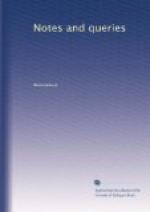Dialogue between a certain Personage and his Minister (p. 442. of the 22nd edition) is by “Ld. J.T.”
A new ballad, Billy Eden, is by “Ld. J.T., or Tickle.”
Ode to Sir Elijah Impey (p. 503.):
“Anonymous—I believe L’d. J.T.”—L.
Ministerial undoubted Facts (p. 511.):
“Lord J. Townsend—I believe.”—L.
W.C. TREVELYAN.
Croker’s Boswell (Edit. 1847, p. 721.).—Mr. Croker cannot discover when a good deal of intercourse could have taken place between Dr. Johnson and the Earl of Shelburne, because “in 1765, when Johnson engaged in politics with Hamilton, {374} Lord Shelburne was but twenty.” In 1765 Lord Shelburne was twenty-eight. He was born in 1737; was in Parliament in 1761; and a Privy Councillor in 1763.
L.G.P.
Misquotation—“He who runs may read.”—No such passage exists in the Scriptures, though it is constantly quoted as from them. It is usually the accompaniment of expressions relative to the clearness of meaning or direction, the supposititious allusion being to an inscription written in very large characters. The text in the prophet Habakkuk is the following: “Write the vision and make it plain upon tables, that he may run that readeth it.” (Ch. ii. 2.) Here, plainly, the meaning is, that every one reading the vision should be alarmed by it, and should fly from the impending calamity: and although this involves the notion of legibility and clearness, that notion is the secondary, and not the primary one, as those persons make it who misquote in the manner stated above.
MANLEIUS.
Tindal’s New Testament.—The following Bibliographical Note, by the late Mr. Thomas Rodd, taken from a volume of curious early Latin and German Tracts, which will be sold by Messrs. Sotheby and Wilkinson on Friday next, deserves a more permanent record than the Sale Catalogue.
“I consider the second tract of particular interest and curiosity, as it elucidates an important point in English literature, viz., the place (Worms) where Tindal printed the edition of the New Testament commonly called the first, and generally ascribed to the Antwerp Press.
“This book is printed
in a Gothic letter, with woodcuts and
Initial Letters (in the year
1518).
“I have carefully examined
every book printed at Antwerp, at the
period, that has fallen in
my way; but in no one of them have I
found the same type or initial
letters as are used therein.
“In the present tract I find the same form of type and woodcuts, from the same school; and also, what is more remarkable, an initial (D) letter, one of the same alphabet as a P used in the Testament. These initial letters were always cut in alphabets, and in no other books than these two have I discovered any of the letters of this alphabet.
“The mistake has arisen
from the circumstance of there having
been a piratical reprint of
the book at Antwerp in 1525, but of
which no copy is known to
exist.”




